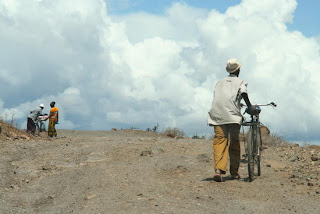I thought I would do a series of blogs on issues that may highlight the differences between life in Arusha and life in Australia. The first is on people transport, from pedestrian, through to the many forms of mechanised conveyances. The next blog will deal with goods transport.
 |
| Clock Tower, Arusha, Tanzania |
There are some significant issues that are important as a backdrop to this discussion. Since Independence, 50 years ago, there has not been much funding or focus on infrastructure or maintenance. Therefore most of the bitumen urban roads in Arusha have deteriorated with many having little or no evidence of bitumen remaining. Arusha has long dry seasons followed by very wet seasons which create very difficult conditions on the dirt roads, most with no separate pedestrian footpaths.
 |
| Typical back street in Arusha, Tanzania
|
 |
| Dusty and bumpy road on the way to fws' Kesho Leo project in Sinon Village |
 |
| Muddy and slippery road for both pedestrians and vehicles |
Travel by foot is the most common form of transport since it is not possible to purchase and maintain a vehicle on very low income levels. Most people walk miles to and from their homes, markets, places of employment, schools and worship (many people attend regular forms of spiritual worship). Women and men take a lot of pride in their appearance and clothing. It is amazing to see the clean state of their clothes after trekking long distances on foot being subjected to either dust or mud (depending on the season). The absence of formed footpaths means pedestrians have to continually vacate the road (in some cases little more than a rough creek bed) and stand on the side as vehicles pass hoping not to be covered in dust or sprayed with mud. It is a constant question as to why there is not more agitation to repair roads, however, I suspect the majority of pedestrians probably prefer the very rough roads as an effective traffic device to slow vehicles down.


The next form of people transport is the pushbike, however, they are not very common probably due to cost and the difficulty of the poor road surfaces and the impracticality in the rainy season. William Msilu, foodwatershelter’s Librarian for the new Kesho Leo Francis Kealy Library, takes great pride in his pushbike but has to spend considerable time after arrival cleaning the mud off his pushbike. During the wet and muddy season he is regularly forced to push or carry his pushbike as the surfaces make riding impossible.
 |
| Road surface too uneven to ride a push bike |
 |
| William, fws' Kesho Leo Librarian, cleans his pushbike before starting work |
A very recent form of people transport is the piki piki (motor bike). This change has occurred in the last 18 months most probably due to the readily available cheap imports from China. There are now hundreds of piki piki in the unregulated taxi industry. Helmets are not common for the riders and are non-existent for their passengers. It is however quicker and arguably more comfortable than the dala dala (local mini bus service) and is quickly assuming a major significance. The cost for a trip of about 6km is 2,000-3,000 Tanzanian shillings (Tsh) or AU$1.30 to $1.80). So, If you like extreme adventure then I would recommend a short trip on one of these!
 |
| A piki piki takes a load... |
The dala dala (local mini bus service) is the most common and economical form of vehicular transport for people. They are designed to accommodate 14 passengers (max) but commonly transport 20+ passengers making for quite uncomfortable conditions. Most are in a poor state of repair, exasperated by the rough roads which take a toll on these light, overloaded vehicles. During the wet seasons, it is not unusual for passengers to have to get out and push the vehicle through the mud. The fare for the same 6km trip is 300Tsh or AU$0.20.
 |
Dala Dala (local mini bus service)
|
Another form of people transport is the taxi which is commonly a standard sedan that is in poor condition. There are no meters calculating the journey’s cost, but you can expect to pay approximately 15,000Tsh (approximately AU$16) for the same 6km trip and is therefore only used by those who have a higher form of income. As taxis are only two wheel drive with standard clearance, they can be somewhat limited in the wet season over all the bumps and pot holes on the roads of Arusha.
Due to such transport limitations, most schools have their own bus services for transporting students, so they are a common sight on the roads. An example of this can be seen with the fleet of buses from The School of St.Jude (largely supported by Australian sponsors) which has a 22 bus fleet for their many students from all over Arusha.
 |
School of St. Jude Bus
|
Arusha is arguably the Safari capital of Africa and therefore a large number of 4 wheel drive safari vehicles, many long wheel base, are specially fitted. Land Rovers are most common for safari vehicles, however, Toyota dominate the vehicles that are generally available. For the more affluent, there a range of expensive 4 wheel drive vehicles that are used.
Larger buses are used for travel between the city centres and between countries, they are generally not air conditioned and are certainly not luxury coaches…..and they go very fast!
 |
| Luxury Bus Coach |
As can be seen, local travel can be challenging and at times a little uncomfortable but it does not seem to greatly concern the locals who accept it and take it in their stride.














No comments:
Post a Comment